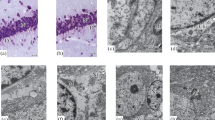Structural changes in hippocampal fields CA1 and CA3 of the ventral part of the hippocampus were studied in 12- and 24-month-old rats (n = 20). Paraffin sections of brains were stained by the Nissl method and the proportion of shrunken neurons with cytoplasmic hyperchromatosis was determined, along with changes in the expression levels of inducible and endothelial NO synthase (iNOS, eNOS). Older rats (24 months) showed more severe signs of neuron damage in the pyramidal layer of hippocampal field CA3. An increase in the proportion of shrunken neurons with cytoplasmic hyperchromatosis was seen, with a decrease in the relative density of neurons, accompanied by pericellular edema, and cytoplasmic vacuolization. An increase in iNOS expression in neurons in the pyramidal layer of field CA3 occurred, with decreases in eNOS expression in fields CA1 and CA3 both in neurons and in vascular endotheliocytes of the microcirculatory bed, as compared with levels in 12-month-old animals.
Similar content being viewed by others
References
K. Yu. Maksimova, S. V. Logvinov, and N. A. Stefanova, “Morphological characteristics of the hippocampus of OXYS and Wistar rats during aging,” Morfologiya, 147, No. 3, 11–16 (2015).
A. V. Tverskoi, A. A. Dolzhikov, I. I. Bobyntsev, et al.., “Morphological changes in neurons in hippocampal fields CA1 and CA3 in rats with chronic restraint stress in a morphometric study),” Kursk. Nauch.-Prakt. Vestn. Chel. Zdorov., No. 3, 37–41 (2014).
G. Aliev, H. H. Palacios, A. E. Lipsitt, et al., “Nitric oxide as an initiator of brain lesions during the development of Alzheimer disease,” Neurotox. Res., 16, No. 3, 293–305 (2009).
S. A. Austin, A. V. Santhanam, and Z. S. Katusic, “Endothelial nitric oxide modulates expression and processing of amyloid precursor protein,” Circ. Res., 107, No. 12, 1498–1502 (2010).
V. Calabrese, C. Mancuso, M. Calvani, et al., “Nitric oxide in the central nervous system neuroprotection versus neurotoxicity,” Nat. Rev. Neurosci., 8, No. 10, 766–775 (2007).
R. A. Chambers and D. W. Self, “Motivational responses to natural and drug rewards in rats with neonatal ventral hippocampal lesions an animal model of dual diagnosis schizophrenia,” Neuropsychopharmacology, 27, 889–905 (2002).
J. Chen, A. Zacharek, C. Zhang, et al., “Endothelial nitric oxide synthase regulates brain-derived neurotrophic factor expression and neurogenesis after stroke in mice,” J. Neurosci., 25, No. 9, 2366–2375 (2005).
S. Desjardins, W. Mayo, M. Vallee, et al., “Effect of aging on the basal expression of c-Fos, c-Jun, and Egr-1 proteins in the hippocampus,” Neurobiol. Aging, 18, No. 1, 37–44 (1997).
G. N. Doherty, “Nitric oxide in neurodegeneration potential benefits of non-steroidal anti-inflammatories,” Neurosci. Bull., 27, No. 6, 366–382 (2011).
K. U. Domek-Łopacińska and J. B. Strosznajder, “Cyclic GMP and nitric oxide synthase in aging and Alzheimer’s disease,” Mol. Neurobiol., 41, 129–137 (2010).
I. Driscoll, S. R. Howard, J. C. Stone, et al., “The aging hippocampus: a multi-level analysis in the rat,” Neuroscience, 139, 1173–1185 (2006).
H. Falougy, E. Kubikova, and J. Benuska, “The microscopical structure of the hippocampus in the rat,” Bratisl. Lek. Listy, 109, No. 3, 106–109 (2008).
P. S. Garry, M. Esra, M. S. Rowland, et al., “The role of the nitric oxide pathway in brain injury and its treatment – from bench to bedside,” Exp. Neurol., 263, 235–243 (2015).
H. Jęśko, M. Chalimoniuk, and J. B. Strosznajder, “Activation of constitutive nitric oxide synthase(s) and absence of inducible isoform in aged rat brain,” Neurochem. Int., 42, 315–322 (2003).
P. Liu, P. F. Smith, I. Appleton, et al., “Age-related changes in nitric oxide synthase and arginase in the rat prefrontal cortex,” Neurobiol. Aging, 25, No. 4, 547–552 (2004).
P. Liu, P. F. Smith, I. Appleton, et al., “Regional variations and age-related changes in nitric oxide synthase and arginase in the sub regions of the hippocampus,” Neuroscience, 119, 679–687 (2003).
P. Liu, P. F. Smith, I. Appleton, et al., “Hippocampal nitric oxide synthase and arginase and age-associated behavioral deficits,” Hippocampus, 15, No. 5, 642–655 (2005).
M. P. Mattson and T. Magnus, “Aging and neuronal vulnerability,” Nat. Rev. Neurosci., 7, No. 4, 278–294 (2006).
G. Paxinos and C. Watson, The Rat Brain in Stereotaxic Coordinates, Elsevier Academic Press, New York (2007), 6th ed.
R. Siciliano, E. Barone, V. Calabrese, et al., “Experimental research on nitric oxide and the therapy of Alzheimer disease: a challenging bridge,” CNS Neurol. Disord. Drug Targets, 10, No. 7, 766–776 (2011).
J. B. Strosznajder, H. Jęśko, A. Zambrzycka, et al., “Age-related alteration of activity and gene expression of endothelial nitric oxide synthase in different parts of the brain in rats,” Neurosci. Lett., 370, 175–179 (2004).
Y. Zhao, P. M. Vanhoutte, and S. W. S. Leung, “Vascular nitric oxide beyond eNOS,” J. Pharmacol. Sci., 129, No. 2, 83–94 (2015).
Author information
Authors and Affiliations
Corresponding author
Additional information
Translated from Morfologiya, Vol. 151, No. 1, pp. 13–19, January–February, 2017.
Rights and permissions
About this article
Cite this article
Smirnov, A.V., Grigor’eva, N.V., Ekova, M.R. et al. Morphological Features of the Ventral Segment of the Hippocampus in Rats on Aging with Reference to the Expression of Inducible and Endothelial NO Synthases. Neurosci Behav Physi 48, 130–135 (2018). https://doi.org/10.1007/s11055-017-0541-9
Received:
Revised:
Published:
Issue Date:
DOI: https://doi.org/10.1007/s11055-017-0541-9



